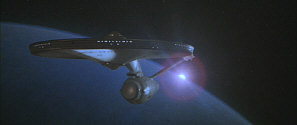 Time for a quick synopsis of my trouble history with Star Trek: The Motion Picture. When this epic hit movie screens in December 1979, I eagerly went to see it and apparently liked it very much. Frankly, I don’t recall the exact feelings it inspired in my 12-year-old self, but I do know that I went on a major Trek binge after that. I constantly watched episodes of the syndicated program - back in the old days when it was just Star Trek and we didn’t need to call it The Original Series - and I even read tons of the show novelizations.
Time for a quick synopsis of my trouble history with Star Trek: The Motion Picture. When this epic hit movie screens in December 1979, I eagerly went to see it and apparently liked it very much. Frankly, I don’t recall the exact feelings it inspired in my 12-year-old self, but I do know that I went on a major Trek binge after that. I constantly watched episodes of the syndicated program - back in the old days when it was just Star Trek and we didn’t need to call it The Original Series - and I even read tons of the show novelizations.
My Trek ardor cooled after that, though I remained moderately interested in the movies. Actually, I came to feel that I liked the films but not the TV show, an emotion that peaked with 1991’s terrific Star Trek VI: The Undiscovered Country. That flick rekindled my desire to revisit its predecessors, so I dropped some big bucks on a special laserdisc package that bundled the first five movies. This 25th anniversary set offered nothing particularly compelling other than a nice case and a couple of doodads, but it saved me some money off the purchase of the LDs separately, which I felt justified it.
I always felt I needed to rationalize my acquisition of all five movies because of ST:TMP. I don’t know when it happened, but sometime between 1979 and 1991 I’d come to dislike the flick. The new viewing of it that accompanied the LD purchase didn’t alter this opinion. While some of the other films in the series have their problems, I thought that ST:TMP was by far the worst of the bunch. Bloated and boring, the movie went nowhere and seemed like a total dud.
Perversely, I tended to check out ST:TMP again every couple of years. During the interim, I’d start to convince myself that the movie wasn’t as bad as I recalled, and I’d give it another chance. Then I’d realize that it really was that terrible. I’d file it away until my memory failed sufficiently to merit another screening.
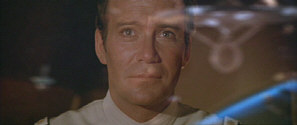 With the appearance of the Trek flicks on DVD, I ditched that LD set quite some time back, so I haven’t watched ST:TMP for at least four or five years now, maybe even more. The DVD release of the film has been a long time coming. Paramount started to issue the Trek movies on DVD back when they initially “embraced” the format in the fall of 1998; Star Trek: First Contact was one of their earliest discs. After that, they popped out a new one on a fairly consistent basis over the following couple of years until Star Trek II: The Wrath of Khan hit in the summer of 2000.
With the appearance of the Trek flicks on DVD, I ditched that LD set quite some time back, so I haven’t watched ST:TMP for at least four or five years now, maybe even more. The DVD release of the film has been a long time coming. Paramount started to issue the Trek movies on DVD back when they initially “embraced” the format in the fall of 1998; Star Trek: First Contact was one of their earliest discs. After that, they popped out a new one on a fairly consistent basis over the following couple of years until Star Trek II: The Wrath of Khan hit in the summer of 2000.
Since then, we’ve waited for ST:TMP, and with great anticipation. All of the prior Trek movie DVDs were very “bare-bones” affairs with virtually no supplements. However, ST:TMP alters that equation, as it provides a two-disc set with many extras as well as a newly edited and redone version of the movie itself.
Called “The Director’s Edition”, I greeted the latter with particular interest. As noted, I’ve long maintained a particular disdain for ST:TMP, but according to director Robert Wise, the theatrical rendition didn’t truly represent his vision for the film. Here are some quotes from his notes in the DVD’s booklet:
Star Trek was a prestigious film for Paramount, and their support was unswerving. Unfortunately, even they couldn’t stop the clock from ticking, and as we began to assess the ambitious technological breakthroughs we were attempting, we gradually realized that it was going to be a race. Thanks to a dedicated case and crew who worked far beyond the call of duty, we survived the chaos of the final weeks and delivered a movie on the date promised…December 7, 1979. We had removed several key dialogue scenes in order to accommodate our incoming effects work, but no time remained to work on properly balancing these two components.
Thanks once again to Paramount’s support, we have been able to complete the film as “The Director’s Edition”. In addition to finding a new, and I feel, proper editorial balance for the film, we have also completed those effects shots and scenes which we had to abort in 1979, and have given the film a proper final sound mix.
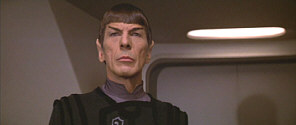 The “Director’s Edition” offers the third version of ST:TMP available on home video. Of course, the original 132-minute theatrical cut is the most widely available, but a 143-minute TV edition also got a release years ago. I don’t know if it can still be found on VHS, but it was out on laserdisc, albeit in a pan and scan transfer.
The “Director’s Edition” offers the third version of ST:TMP available on home video. Of course, the original 132-minute theatrical cut is the most widely available, but a 143-minute TV edition also got a release years ago. I don’t know if it can still be found on VHS, but it was out on laserdisc, albeit in a pan and scan transfer.
I never saw the TV edition, so I don’t know how it compares to the theatrical one and the “Director’s Edition”. Length-wise, the latter falls between the two. It runs 136 minutes. Ala Spielberg’s 1998 cut of Close Encounters of the Third Kind, the new ST:TMP drops some material from the original release while it provides additional footage. However, unlike Spielberg’s tinkering, the new ST:TMP doesn’t just combine the two prior versions; it alters a lot of it for a new experience.
Or so I hoped. I went into my screening of the “Director’s Edition” warily, as I wanted to finally like the movie, but without great hopes that this would occur. Star Trek: The Motion Picture follows the reunited crew of the Enterprise. A mysterious force steadily approaches Earth, and it destroys pretty much everything in its path. The Enterprise is still going through a refitting, but they’re the only ship that can possibly intercept the cloud. After a few years as a desk jockey, Captain Kirk (William Shatner) badly wants to get back on the bridge, so he uses this calamity to wrest back control of the Enterprise from young Captain Decker (Stephen Collins). This doesn’t sit well with the younger officer, but he has no choice other than to suck it up and go along with the decision. He remains on board as science officer when a mishap kills the Enterprise’s already-designated employee.
Slowly - and I do mean slowly - the film conspires to bring back all of the show’s old regulars. It appears that most of them - Uhura (Nichelle Nichols), Chekov (Walter Koenig), Scotty (James Doohan) and Sulu (George Takei) - already worked on the redone Enterprise, along with more obscure figures like Doctor - formerly Nurse - Chapel (Majel Barrett) and Lt. Commander - formerly Yeoman - Rand (Grace Lee Whitney). However, Kirk’s main compatriots had to come aboard via different means. Retired from Starfleet, Dr. McCoy (DeForest Kelley) has to be drafted to return, while Mr. Spock comes back for more personal reasons. After years on his home planet of Vulcan in pursuit of the Kolinahr discipline - which would purge all emotions from him - he fails to pass a test, largely because he senses the presence of the V’ger spirit. As such, he rejoins the crew largely to find his own answers about this mysterious entity.
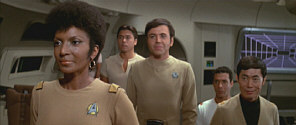 Another dynamic occurs when Lieutenant Ilia (Persis Khambatta) joins the crew. A Deltan - apparently a very sex-oriented people - she and Decker once had a fling, and her presence stirs up some old memories.
Another dynamic occurs when Lieutenant Ilia (Persis Khambatta) joins the crew. A Deltan - apparently a very sex-oriented people - she and Decker once had a fling, and her presence stirs up some old memories.
All of that exists as a backdrop to the Enterprise’s attempt to reach, contact, and deal with V’ger. Does any of it really matter? No, for the very simple story is told in such a turgid manner that all considerations become subsumed to the dull pacing.
Defenders of ST:TMP like to tell us how intelligent it is, which implies that non-fans must be too moronic to comprehend its intricacies and depth. Feh! In truth, ST:TMP does possess a moderately intriguing story. The questions that surround V’ger seem interesting, and Spock’s relationship to the entity also had some potential. Add to this Kirk’s burgeoning midlife crisis and the interactions between Ilia and Decker and on paper, you have something.
Onscreen, the reality seems totally different. Through this “Director’s Edition”, Wise trimmed some scenes and added to others, but the overall effect made no difference. The movie still appears short on story and long on endless special effects shots.
Oh my, does ST:TMP pour on the visual imagery! The Enterprise doesn’t even leave port until 37 minutes into the movie, and much of the reason for that relates to the interminable loving glimpses of various elements. The movie should have been called Star Trek: Check Out Our Bitchin’ New Budget! It feels as though so much time was devoted to impressing us with effects that blow away those from the old show that no one bothered to notice how terribly boring they were.
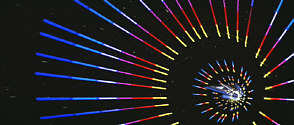 This tendency does have its defenders as well. When I waited tables in college, I worked with a serious Trekkie, and he felt that the never-ending early shots of the Enterprise were warranted because the die-hard fans wanted to see them. I’m sure that’s true, and I’m also sure that they loved the intricacy of the imagery. However, it’s not good filmmaking. These shots - and many more like them throughout ST:TMP - do absolutely nothing to further the plot, and they slow down the movie immeasurably.
This tendency does have its defenders as well. When I waited tables in college, I worked with a serious Trekkie, and he felt that the never-ending early shots of the Enterprise were warranted because the die-hard fans wanted to see them. I’m sure that’s true, and I’m also sure that they loved the intricacy of the imagery. However, it’s not good filmmaking. These shots - and many more like them throughout ST:TMP - do absolutely nothing to further the plot, and they slow down the movie immeasurably.
Frankly, ST:TMP has a story that easily could have fit into a regular episode of the show. In fact, what we find comes across as little more than a regurgitation of one of Trek’s basic plots. It features an apparently omnipotent force that has to be outwitted by Kirk’s ingenuity. We saw this tale many times during the original series, and ST:TMP does nothing to improve upon the plot.
If anything, it seems like a poor variation on the story, mainly because the film drones on for so long. Some wags have dubbed this film Star Trek: The Motionless Picture, and it’s hard to disagree with them. The movie moves so slowly, and little really happens. The picture’s more about reaction than action. While I didn’t expect it to be a slam-bang, Star Wars-esque affair, it should have struck a more satisfying balance.
That would have to wait for the film’s sequels, all of which improved upon this clunker. Yes, I include much-maligned efforts such as 1984’s Star Trek III: The Search for Spock and 1989’s Star Trek V: The Final Frontier. For all their faults - and they do include many - they simply felt more like real Trek than did ST:TMP. The latter came across like imitation Trek. The series was always accused of being too serious and without humor, but that wasn’t the truth. However, ST:TMP offered Trek foes evidence of their theory with its flat pacing and lack of charisma.
 Despite its recycled plot and frighteningly slow progress, I could have gotten into ST:TMP had it displayed any sign of the original show’s spark. However, that wasn’t the case, as the long-time collaborators in the cast seemed to be virtual strangers here. I got no sense of the original show’s fine camaraderie or spirit, as everyone appeared morose and unenthusiastic. The scenes that focused on Kirk, McCoy and Spock - the triad at the heart of the old series - came across as bland and drab.
Despite its recycled plot and frighteningly slow progress, I could have gotten into ST:TMP had it displayed any sign of the original show’s spark. However, that wasn’t the case, as the long-time collaborators in the cast seemed to be virtual strangers here. I got no sense of the original show’s fine camaraderie or spirit, as everyone appeared morose and unenthusiastic. The scenes that focused on Kirk, McCoy and Spock - the triad at the heart of the old series - came across as bland and drab.
Nimoy seemed most unhappy to be on the set; he constantly looked like he really didn’t want to be there. In his 1995 autobiography called I Am Spock, Nimoy claimed that he was happy to do the flick, but he made his concerns known:
Once filming commenced, it seemed like we actors stood forever on the bridge of the Enterprise, staring at a blank screen, which later would be filled with wondrous special effects. This work was very tedious, and frankly, not much fun. What was this gloom? This depressed atmosphere? This lack of attack, fun, élan?
I think it came out of a sense that we were doing something Historic and Important. Somehow, although the TV shows depended heavily on the day-to-day energy of the creative community - writers, directors and actors - the movie seemed to have been taken out of our hands. And our energy was sapped by an unwarranted reverence. We were passengers along for the ride on a voyage we could never quite fully manage or understand.
Of the movie’s premiere, Nimoy added:
What do I remember of the movie that I saw? Incredible shots of the Enterprise, looking more massive and awesomely beautiful than she ever had.
And then more shots of the Enterprise, looking massive and beautiful.
And more shots…
Eventually, the special effects became downright tedious. A great cheer came up from the audience when the ship went into warp speed, but unfortunately the story never really took flight - and the chemistry between the characters was never taken advantage of.
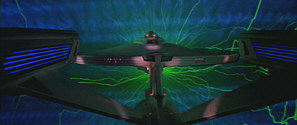 And those comments essentially encapsulate everything that’s wrong about Star Trek: The Motion Picture. It stand as a monument to special effects wizardry, as it looks about 10 billion times better than anything we ever saw on the original show. However, it fell so deeply in love with those visuals that it left room for little else, and the wonderful spirit the cast displayed on the series was nowhere to be found.
And those comments essentially encapsulate everything that’s wrong about Star Trek: The Motion Picture. It stand as a monument to special effects wizardry, as it looks about 10 billion times better than anything we ever saw on the original show. However, it fell so deeply in love with those visuals that it left room for little else, and the wonderful spirit the cast displayed on the series was nowhere to be found.
I’ve always preferred the original show to The Next Generation because of that chemistry. Admittedly, the performers on the newer program can act rings around those found on the old one, but I never felt they were able to duplicate the fine spark the original showed. There was a sense of fun, excitement and distinctive character that seemed to disappear somewhat on later iterations; for all the talent involved, they never came across with the same spunk and charm.
Unfortunately, neither did Star Trek: The Motion Picture, and it made the original cast look nearly embalmed. As a Trek fan, I owe the film a debt of gratitude, for it essentially resurrected the franchise and allowed us to partake of the many more satisfying efforts that came over the last 22 years. Nonetheless, it remains a bloated and boring flick, and though I appreciate director Robert Wise’s attempts to tighten the film, he didn’t succeed; the “Director’s Edition” seems as dull and pointless as ever.
Odd footnote: I don’t know the characters name, but did anyone else think that one of the prominent aliens who served on the Enterprise bridge looked a lot like comedian Steven Wright?
Interesting realization: The “Director’s Edition” is rated “PG”, but the original film received a “G”. Frankly, I’m not sure what necessitated this change, as the new version doesn’t seem any nastier to me.
The DVD:
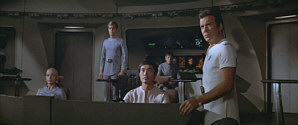 Star Trek: The Motion Picture appears in an aspect ratio of approximately 2.35:1 on this single-sided, dual-layered DVD; the image has been enhanced for 16X9 televisions. An erratic picture that often showed its age, ST:TMP generally looked fairly good, but it ran into concerns at times.
Star Trek: The Motion Picture appears in an aspect ratio of approximately 2.35:1 on this single-sided, dual-layered DVD; the image has been enhanced for 16X9 televisions. An erratic picture that often showed its age, ST:TMP generally looked fairly good, but it ran into concerns at times.
Sharpness usually seemed reasonably crisp and accurate, but this element was a bit erratic. At times, the image came across as somewhat blurry and soft, and it could look a bit indistinct. Most of the movie appeared acceptably detailed, but the fuzziness seemed a little distracting at times. Moiré effects and jagged edges caused no concerns, and I also detected no signs of edge enhancement.
Print flaws provided a mix of issues. Grain appeared during a fair amount of the movie, and a mix of speckles and grit showed up with moderate frequency throughout the film. The defects weren’t overwhelming, but the movie could look rather dirty at times. Effects shots caused a lot of the concerns, which I expected; the overlapping layers involved often add to the appearance of flaws. However, many shots that didn’t involve these elements also looked problematic.
Despite the vivid colors seen in the original show, director Robert Wise wanted a more subdued look for ST:TMP, and that resulted in a fairly bland look much of the time. The DVD usually replicated these earthy tones with good accuracy. There was little that seemed terribly interesting, but I thought the disc showed the colors reasonably well. However, I did feel the tones seemed a bit erratic, and they looked vaguely flickery on occasion.
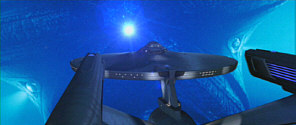 Black levels were generally good, though they could appear somewhat inky at times. Shadow detail was acceptably clear and discernible, though the mildly muddy blacks rendered low-light situations a bit less attractive than I’d like. Ultimately, much of ST:TMP looked reasonably positive, but the image displayed enough concerns to knock down my rating to a “B-“.
Black levels were generally good, though they could appear somewhat inky at times. Shadow detail was acceptably clear and discernible, though the mildly muddy blacks rendered low-light situations a bit less attractive than I’d like. Ultimately, much of ST:TMP looked reasonably positive, but the image displayed enough concerns to knock down my rating to a “B-“.
Much more impressive was the Dolby Digital 5.1 soundtrack of Star Trek: The Motion Picture. Its soundfield provided a surprisingly active and involving experience. Music displayed excellent stereo separation and presence, while effects showed solid distinction and accuracy. The forward spectrum offered a realistic - within the sci-fi environment, at least - and engaging presentation that gave us a good sense of atmosphere. The surrounds were more restricted, but they added a nice feeling of reinforcement, and they became pretty active partners at times; for example, the wormhole sequence seemed very satisfying.
Audio quality also seemed excellent for the most part, though one area was a substantial disappointment: speech. Much of the time, dialogue sounded fairly natural and distinct, but on many occasions, the lines became very edgy and rough. This problem reached its peak during the energy probe sequence - which was also possibly the scene that depicted the most visual problems - but that part didn’t stand alone, as the speech often appeared distorted.
Otherwise, the sound seemed terrific. Music was consistently bright and rich, as Goldsmith’s score appeared dynamic and distinct. Low-end response was quite solid, and the highs came across as clean and vivid. Effects worked equally well, as they packed a solid punch and seemed consistently accurate and showed fine presence. I fluctuated between an “A-“ and a “B+” grade for the audio of ST:TMP, mainly because the speech often sounded so poor. However, the rest of the track worked so incredibly well that I thought it balanced the weaknesses of the dialogue; as such, I went with the higher grade.
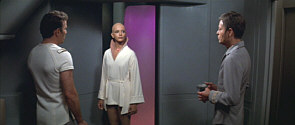 As noted earlier, all of the other eight Star Trek films on DVD are very light on extras. Of the bunch, 1986’s Star Trek IV: The Voyage Home and 1998’s Star Trek: Insurrection were the most packed, and they only included some minor featurettes. For the others, we found trailers or less.
As noted earlier, all of the other eight Star Trek films on DVD are very light on extras. Of the bunch, 1986’s Star Trek IV: The Voyage Home and 1998’s Star Trek: Insurrection were the most packed, and they only included some minor featurettes. For the others, we found trailers or less.
Happily, that situation should eventually be rectified. Starting with this two-DVD set, Paramount have indicated that they will reissue all of the Trek flicks as full special editions. Apparently that trend will bring us the movies in chronological order; a new version of 1982’s Wrath of Khan may appear in 2002.
Based on what I found here, I hope that’s the case, for the special edition of ST:TMP was a solid piece of work. On DVD One, we find two extras in addition to the expanded film itself. Foremost is an audio commentary from director Robert Wise, special photographic effects director Douglas Trumbull, special photographic effects supervisor John Dykstra, music composer Jerry Goldsmith, and actor Stephen Collins. All five men were recorded separately for this edited but largely screen-specific track.
Overall, I thought the commentary was decent but erratic. It started well, as the first third or so of the movie included a lot of good information. Wise dominated, as he added nice notes about his involvement in the film and interesting topics like the dubbing and translation of the Vulcan speech and his rationale for some of the storytelling. Wise also provides comments about the changes he made between the original theatrical cut and the “director’s edition”. Goldsmith and Collins add little, but Dykstra and Trumbull provide useful material about the effects.
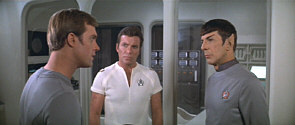 After a while, however, the commentary starts to fade. Pauses between remarks become longer and more frequent, and the statements themselves seem less compelling. Wise often simply relates the on-screen action, though he usually offers reasonably interesting information, and the effects guys continue down the same path as earlier; this becomes a little redundant after a while, but it remains acceptably useful. Collins and Goldsmith continue to be MIA for the most part. In fact, Collins only appears once before the film’s “climax”; during that period, we heard a little more from him, but he’s still a minor participant. Overall, the track seems sporadically entertaining and noteworthy, but it appears generally average.
After a while, however, the commentary starts to fade. Pauses between remarks become longer and more frequent, and the statements themselves seem less compelling. Wise often simply relates the on-screen action, though he usually offers reasonably interesting information, and the effects guys continue down the same path as earlier; this becomes a little redundant after a while, but it remains acceptably useful. Collins and Goldsmith continue to be MIA for the most part. In fact, Collins only appears once before the film’s “climax”; during that period, we heard a little more from him, but he’s still a minor participant. Overall, the track seems sporadically entertaining and noteworthy, but it appears generally average.
In addition, the movie can be viewed with a text commentary. Created by Michael Okuda, the co-author of the Star Trek Encyclopedia, this piece provides a lot of little factoids at the bottom of the screen throughout the movie. Most of these stick with technical facts, as special effects, sets and props dominate the commentary. In addition, we learn some interesting tidbits about the cast and crew as well various film-related trivia; for example, we find out about the backstory created for Ilia and Decker, and also hear how it got transmuted into the affair between Riker and Troi in The Next Generation. Overall, this was a nice little track that offered some good details.
Now we move to DVD Two, where a wealth of addition extras awaits. First we locate three new documentaries that relate to the film. The opening one takes a look at the project’s early genesis as a new TV show. Phase II: The Lost Enterprise relates details about this almost-aired production through stills, some test footage, and new interviews with some who participated in it. We hear from Roddenberry’s widow and Trek actress Majel Barrett, story editor Jon Povill, co-producer Harold Livingston, secretary Michele Billy-Povill, actor David Gautreaux, and Judith and Garfield Reeves-Stevens, authors of a book about the program. The 12-minute and 40-second show offers a decent look at the aborted version of Trek and integrates it into the start of ST:TMP, but it felt a little rushed and superficial to me.
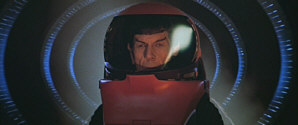 Next up is A Bold New Enterprise: The Making of Star Trek: The Motion Picture. This 29-minute and 40-second piece provides a general overview of the movie’s creation, as it combines the usual mix of film clips, production stills, and new interviews. In the latter category we hear from actors William Shatner, Walter Koenig, Stephen Collins, and David Gautreaux, director Robert Wise, editor Todd Ramsay, associate producer Jon Povill, writer Harold Livingston, former Paramount executives Jeffrey Katzenberg and Tom Parry, effects supervisors John Dykstra, Douglas Trumbull, and Richard Yuricich, and composer Jerry Goldsmith.
Next up is A Bold New Enterprise: The Making of Star Trek: The Motion Picture. This 29-minute and 40-second piece provides a general overview of the movie’s creation, as it combines the usual mix of film clips, production stills, and new interviews. In the latter category we hear from actors William Shatner, Walter Koenig, Stephen Collins, and David Gautreaux, director Robert Wise, editor Todd Ramsay, associate producer Jon Povill, writer Harold Livingston, former Paramount executives Jeffrey Katzenberg and Tom Parry, effects supervisors John Dykstra, Douglas Trumbull, and Richard Yuricich, and composer Jerry Goldsmith.
As with the show about Phase II, “Bold” feels a little glossy and without depth, but it provides a reasonably nice depiction of the movie’s progress. It omits much notice about the problems that arose, other than the usual complaints about the rushed production, and it also suffers from repetition after the two commentaries on DVD One. Nonetheless, it’s good to hear some different viewpoints, and a mix of new material appears, such as the presentation of a music cue rejected for the film; Goldsmith altered it slightly to create the theme we now know, and I enjoyed tidbits such as that.
Entitled Redirecting the Future, the final documentary gives us information about the alterations made for the “Director’s Edition”. The 14-minute and five-second piece mainly examines the updated and completed effects shots. It combines interviews, archival material, and shots that compare the original material with the new images. The last are especially valuable, since they demonstrate exactly how the two versions differ.
In the interview camp, we get some minor comments from actors Shatner and Koenig, director Wise, and editor Ramsay, but most of the show concentrates on those involved solely with the “Director’s Edition”. We hear from restoration supervisor Mike Matessino, “Director’s Edition” producer David C. Fein, “Director’s Edition” visual effects supervisor Daren Dochterman, and a bunch of folks from Foundation Imagery, the effects house that worked on the new version: Adam Lebowitz, Ron Thornton, John Teska, David Morton, Trevor Pierce, Robert Bonchure, Sherry Hitch, Bob Quinn, PJ Foley, and Lee Stringer.
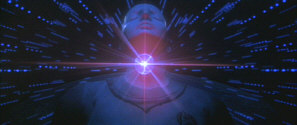 “Redirecting the Future” is probably the most satisfying of the three documentaries, largely because it’s the only one that seems fairly complete. It shows the effects updates in a clear and efficient manner, and it complements the verbal discussions heard during the commentary. Wise iterated the story changes he made, and here we can see the visual alterations. Ultimately, it’s a good piece for those who want to compare the two versions of the movie.
“Redirecting the Future” is probably the most satisfying of the three documentaries, largely because it’s the only one that seems fairly complete. It shows the effects updates in a clear and efficient manner, and it complements the verbal discussions heard during the commentary. Wise iterated the story changes he made, and here we can see the visual alterations. Ultimately, it’s a good piece for those who want to compare the two versions of the movie.
Within the Publicity Materials area we find various promotional pieces. Three trailers appear. There’s the teaser, the full theatrical trailer, and a clip for the new “Director’s Edition”. Interestingly, I believe that Orson Welles narrated the teaser! In addition, we find an ad for the new Enterprise TV show.
The Additional and Deleted Scenes area adds a sizable collection of material. It splits into two sections: “1979 Theatrical Version” and “1983 TV Version”. The former includes five scenes that were altered for the “Director’s Edition” as well as some “Trims” from the theatrical cut and one “Outtake”. Each of these lasts between two minutes, 34 second and five minutes, 44 seconds, for a total of 28 minutes and 23 seconds of footage. I was happy to see the inclusion of these clips, since they let us see the original footage, but overall, they felt a bit dull; they provided little that was new, since the majority depicted scenes that appeared in the “Director’s Edition”, albeit in altered renditions. Still, I thought they were a valuable and appropriate addition to the DVD.
More intriguing are the clips from the “1983 TV Version”. As I noted earlier, that rendition extended the theatrical version by 11 minutes, and some of those shots made it into the “Director’s Edition”. Those that didn’t make the cut appear here. We get 11 of them in all, and they last between 12 seconds and 79 seconds for a total of eight minutes and 13 seconds of footage. As their brief lengths indicate, none of these offered anything terribly substantial, but there was some interesting material in here. I especially liked a snippet between Sulu and Ilia.
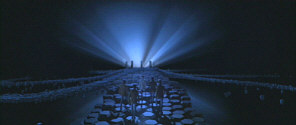 Lastly, the Archives rounds out DVD Two with a series of storyboards. We find images for the following sequences: “Vulcan” (15 frames), “Enterprise Departure” (30 stills), and “V’ger Revealed” (39 shots). They’re surprisingly cartoony, but they should be satisfying for fans of the flick. In addition, the DVD’s booklet adds a listing of the disc’s supplements as well as the note from Wise I mentioned earlier.
Lastly, the Archives rounds out DVD Two with a series of storyboards. We find images for the following sequences: “Vulcan” (15 frames), “Enterprise Departure” (30 stills), and “V’ger Revealed” (39 shots). They’re surprisingly cartoony, but they should be satisfying for fans of the flick. In addition, the DVD’s booklet adds a listing of the disc’s supplements as well as the note from Wise I mentioned earlier.
As usual, Paramount have added closed captioning and English subtitles to most of the DVD’s extras. The trailers lack any text, and I was surprised the French subs Paramount normally include weren’t here, but that’s a minor complaint since they’re the only studio that consistently provides this feature. CC and/or subtitles for supplements really should be standard for all supplements.
Ugh, what a terrible dilemma! Paramount finally release a nice special edition of a Star Trek film, but it’s the only one of the nine that I can’t stand: 1979’s Star Trek: The Motion Picture. I want to like this movie, and I’ve given it repeated chances to win my affection, but it always fails miserably. The flick consistently appears cold, clinical and sterile, as it displays few signs of the joie de vivre and energy seen on the original program.
As for the DVD, it offers flawed but generally good picture with flawed but generally excellent sound as well as flawed but generally compelling and useful extras. For diehard Trek fans, I have to admit Star Trek: The Motion Picture is a “must-have”; as much as I dislike the movie, it’s a solid package, and it’s something I’ll keep in my collection, if just for curiosity value. However, those without a strong affection for Trek should skip it; the movie seems unlikely to attract many new fans, and it appears more likely to actively dissuade newcomers from embracing the series.